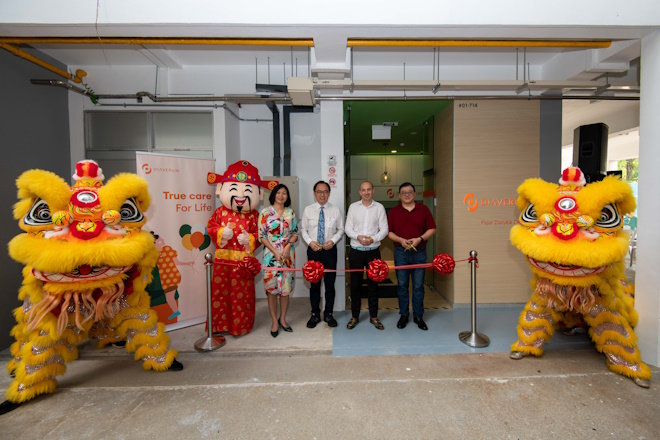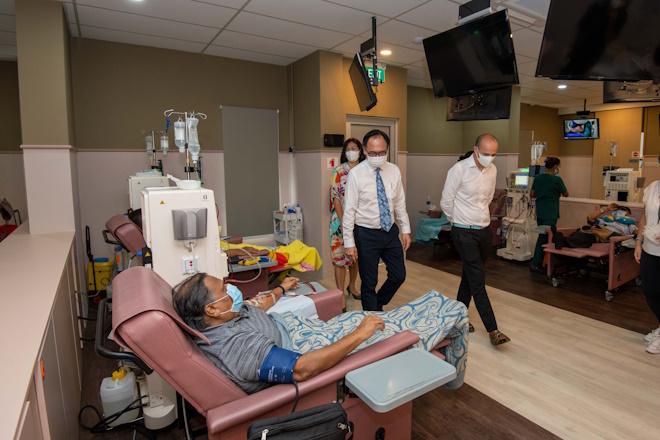
Insights + interviews
Diaverum opens first private dialysis clinic in a HDB community space
Diaverum has opened Singapore’s first-ever private dialysis centre in a Housing Development Board (HDB) community space.
Located in the Fajar residential estate, Diaverum’s Fajar Dialysis Centre marks a significant milestone in Singapore’s healthcare landscape, reinforcing the importance of public-private partnerships (PPPs) in providing greater access to chronic disease care and management across the country.
Chronic kidney disease (CKD) is a global and escalating challenge today affecting about 10 percent of the world’s adult population. It is primarily caused by lifestyle diseases such as diabetes, and its prevalence is increasing, particularly in developing countries and among low income individuals.
In Singapore, over 5 percent of the population are affected by CKD, with a growing prevalence of diabetes from 8.2 percent in 2010 to 11.3 percent in 2020.
I am very heartened with the opening of Diaverum’s brand-new dialysis centre at Bukit Panjang. It is a positive step forward, and I want to congratulate and thank the Diaverum team for their commitment to providing top quality care to patients with chronic kidney disease in Singapore. I look forward to seeing more of such collaborations with Diaverum providing meaningful renal care support and superior
Liang Eng Hwa, Member of Parliament (Bukit Panjang SMC) speaking at the Opening ceremony
treatment facilities in the years ahead, also contributing to Singapore’s vision of a happier, healthier and more empowered population.
Diaverum is a healthcare organisation that provides life-enhancing renal care to patients with CKD.

We discuss the background, challenges and profiles of dialysis patients in Singapore and possibly the new Fajar Dialysis Centre with Mr Hervé Gourgouillon, Regional Vice-President for West Europe and Southeast Asia, Diaverum.
the Active Age (AA): What is the background behind conceptualising and developing the first private Dialysis Clinic in a HDB community space?
Mr Hervé Gourgouillon (HG): It has been a very rewarding journey towards establishing the first private dialysis clinic in a HDB void deck.
Prior to the move, we were operating a clinic a few blocks away in a Senior Activity Centre (SAC) lot. However, our lease was winding up and we needed to ensure that our patients would continue to have access to the renal care that is essential to their survival. We wanted to ensure that any new location secured would be an easy transition for our patients and keep any inconvenience to a minimum.
In fact, we were very heartened when a few of our patients and their caregivers reached out to Bukit Batok SMC’s MP Liang Eng Hwa to ask for a solution that would allow them to continue receiving treatment with Diaverum. With their support and the hard work of our team, we were able to find a wonderful solution that not only ensured that we can continue caring for our patients in a comfortable and convenient space, but also set a positive precedent for future clinic locations.
AA: What were some challenges that Diaverum came across in this public-private partnership, and how did you overcome them?
HG: Public-private partnerships (PPP) form an essential part of our strategy across all markets of operation. For us, this approach supports and taps into the public healthcare infrastructure, while empowering patients’ access to our life-enhancing renal care. By leveraging on the strengths of both sectors, PPPs are able to improve patient care outcomes and experiences.
Each market comes with its unique challenges. In Singapore’s case, it is very much due to the limited land space that the country has to contend with. It is a very real constraint that impacts multiple sectors, including essential healthcare services such as ours. Enhancing accessibility for patients across the island is our long-term plan for the country, and that means locating suitable spaces that are convenient and highly accessible to our patients – even when space is limited.
The idea of setting up our newest Dialysis Centre in a void deck space was a brand new challenge not just for us, but for the authorities. As the void decks have always been earmarked for community activities and public sector services, the proposal to set up a privately-run clinic in this space was unprecedented.
To overcome this, we worked closely under the guidance of MP Liang Eng Hwa and his team to better understand the regulations and requirements from the perspective of the HDB, Building Construction Authority (BCA) and Town Council. This helped us create the right frameworks to get our proposal across the line and materialise the Fajar dialysis clinic.
Inevitably for a project of this magnitude and complexity, we did encounter challenges, but with the support shown by MP Liang and our patients, we believe the stage has been set for continued collaboration to further our clinic network for greater patient access and convenience.

AA: What is the typical profile of dialysis patients you see in this clinic compared to the other 11 clinics that you operate in Singapore?
HG: Our patients are of a similar profile across our clinics, and usually reside in the neighbouring vicinity. This reflects our commitment to providing quality care in convenient locations across the country, ensuring easy access for patients as they undergo multiple sessions each week.
Our patients in Singapore are of an average age of 65 and above – which is a reflection of the national statistics – with patients seeking treatment at our clinics for diabetes and the management of related conditions such as hypertension.
AA: Can you elaborate more on your proprietary care model, and how it is being enhanced/complemented by the digital infrastructure Diaverum has set in place?
HG: Our proprietary and digitalised care model, or Diaverum Care Delivery Model, is designed to ensure improved medical outcomes and to contribute towards further higher longevity and lower hospitalisation rates of our patients.
This is achieved through a standardised care model that is embedded in robust clinical governance and supported by our continuously evolving digital infrastructure.
Our Care Delivery Model consists of five key pillars:
- Clinical Standards: policies and procedures that ensure high quality of care and patient safety
- Medical Standards: comprehensive therapeutic protocols that optimise medical outcomes through the most efficient care delivery
- Performance Measurement: continuous monitoring of medical outcomes
- Patient and Staff Education: in both virtual and physical settings
- Scientific Research: based on the needs and priorities of renal patients
The Care Delivery Model is supported by a robust digital infrastructure that includes proprietary software such as the renal information management system d.CARE, the Treatment Guidance System (TGS), Pharma Guidance System (PGS) and our virtual educational platform, d.ACADEMY.
These digital tools enable care standardisation and thus enhance and improve patient safety, workflow management and medical outcomes.
Diaverum’s Care Delivery Model

AA: What other plans does Diaverum have for future growth in Singapore?
HG: With multiple underserved regions in Singapore, our immediate and long-term roadmap for the country is to continue expanding our clinic network and improve patient accessibility to quality renal treatment and care. Estates such as Seng Kang and Punggol are on our radar at the moment.
Our Fajar clinic is an example of what we plan to accomplish in the years ahead for our patients in Singapore. Set in a location that places treatment access much closer to patients, we want this process to be easy, comfortable and accessible for patients across the country. This is what the Fajar clinic is able to provide for our patients, and is an approach that we plan on replicating to serve other communities across Singapore.
Pictures provided by Diaverum






